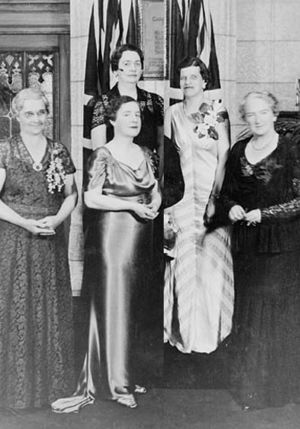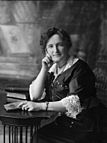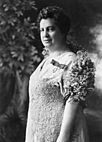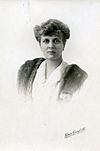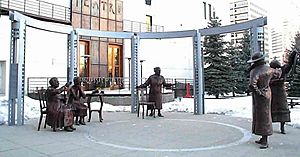The Famous Five (Canada) facts for kids
The Famous Five (French: Célèbres cinq) were five amazing Canadian women who fought for the rights of women and children. Their names were Henrietta Muir Edwards, Nellie McClung, Louise McKinney, Emily Murphy, and Irene Parlby. On August 27, 1927, they asked the Canadian government to find out if women could become senators. This request led to a very important court case called the Persons Case.
Even though most Canadian women could vote by 1927, they still faced many limits. The Persons Case was a big step towards women having equal rights in Canada. It helped start the first wave of feminism, which was a movement for women's equality.
The government asked the Supreme Court of Canada a simple question: "Does the word 'Persons' in Section 24 of the British North America Act, 1867 include women?" In 1928, the Supreme Court said no. They decided that women were not "qualified persons" for the Senate.
The Famous Five did not give up! They appealed this decision to a higher court in the British Empire, called the Judicial Committee of the Privy Council. On October 18, 1929, this higher court overturned the Supreme Court's ruling. They said that women were "qualified persons" and could be appointed to the Senate. This was a huge victory for women's rights in Canada.
Contents
Meet the Famous Five Women
The Famous Five included Emily Murphy, Henrietta Muir Edwards, Nellie McClung, Louise McKinney, and Irene Parlby. These five women were very important in Canadian history. They spent their lives fighting for change, starting in the 1880s and 1890s. Because they first met in Alberta, they were sometimes called The Alberta Five. But their work was so important for all of Canada that they became known as The Famous Five.
Henrietta Muir Edwards' Contributions
Henrietta Muir Edwards was a writer and researcher focused on women's issues. She was very influential in the National Council of Women of Canada. For over 35 years, she led the law committee there. She was also a leader for the Red Cross during World War I. Edwards helped start the Victorian Order of Nurses, too.
Nellie McClung's Achievements
Nellie McClung had many different jobs. She was a teacher, author, and public speaker. She was also a strong activist for women's rights and temperance (limiting alcohol). In 1921, McClung was elected to the Alberta legislature as a Member of the Legislative Assembly (MLA). She was the first woman on the Canadian Broadcasting Corporation Board of Governors. McClung famously said, "I've never thought minding my own business is much of a virtue. Too often it's just an excuse for not taking action when action needs taking!" She was a key leader in the "Mock Parliament" in 1914. This event humorously discussed "Votes for Men" to show how unfair it was that women couldn't vote.
Louise McKinney's Political Role
Louise McKinney made history as one of the first two women elected to a legislature in the British Empire. She was also the first to take her seat. McKinney helped start the Woman's Christian Temperance Union in Alberta. She served as its vice-president for more than 22 years. She was one of the women who signed the appeal to the Privy Council in 1929. In 1931, she became president of the Canadian Union of the Woman's Christian Temperance Union.
Emily Murphy's Judicial Career
Emily Murphy was a standout among the Famous Five. She became the first female judge in the British Empire. In 1916, Emily was appointed as a magistrate for the Edmonton Juvenile Court. Later, she became the magistrate of the new Women's Court. At that time, no woman had ever held such a position. Many men were against it. Emily Murphy was truly a pioneer for women in the legal field. She also wrote books using the pen name "Janey Canuck." In 1958, the Canadian government recognized Emily Murphy as a Person of National Historic Significance.
Irene Parlby's Government Service
In 1916, Irene Parlby was elected the first president of the United Farm Women of Alberta. In 1921, she was elected to the Alberta legislature. She then became a Cabinet minister in the government. This made her the second woman in the British Empire to hold such a high government position. She was also the first female Cabinet minister in Alberta. Parlby continued to serve as a minister until 1935. She also worked with the Red Cross during World War I. Later, she served on the Board of Governors for the University of Alberta.
The Persons Case Explained
For about 10 years, people discussed whether women could be in the Senate. But in 1927, the Canadian law seemed to say it was impossible. In August 1927, Emily Murphy invited Nellie McClung, Irene Parlby, Louise McKinney, and Henrietta Muir Edwards to her home. They met to plan how to ask the Canadian government to get a court ruling. They wanted to know if the word persons in the British North America Act included women.
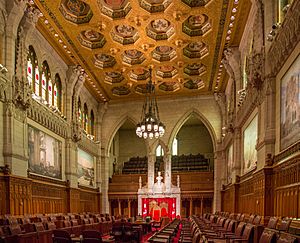
On August 27, 1927, the five women sent their petition to the Governor General of Canada. They asked the government to ask the Supreme Court if a woman could be appointed to the Senate of Canada. In response, the government asked the Supreme Court this question: "Does the word 'Persons' in section 24 of the British North America Act, 1867, include female persons?"
On April 24, 1928, the Supreme Court decided that women were not "qualified persons." They said the law should be understood as it was in 1867. They believed the law would have specifically mentioned women if they were meant to be senators.
The Famous Five then appealed this decision to the Judicial Committee of the Privy Council. This was the highest court of appeal at the time. On October 18, 1929, the Judicial Committee agreed with the Famous Five. They overturned the Supreme Court's decision. The Judicial Committee concluded that the word "persons" does include women. This meant women were eligible to become members of the Senate of Canada.
The judge, Viscount Sankey, explained the decision. He said that keeping women out of public jobs was "a relic of days more barbarous than ours." He also said that laws should change with the times. This decision was a huge victory. It officially marked October 18, 1929, as the start of a new era for women's rights in Canada.
The Lasting Impact of the Famous Five
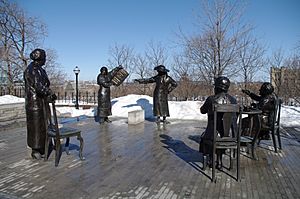
The Famous Five worked hard to get women into the Senate. While none of the five women ever became senators themselves, they opened the door for others. Cairine Wilson became the first female senator in Canada.
These five women were activists in many areas. They always worked to improve life for women and children.
How They Are Remembered
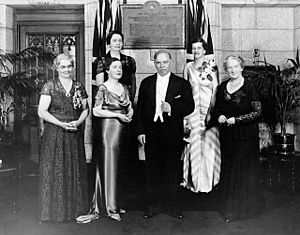
The Famous Five are remembered in many ways. There are plaques for them in Canada's Senate building. Two identical sculptures by artist Barbara Paterson honor them. One is on Parliament Hill in Ottawa, and the other is at the Olympic Plaza in Calgary. The sculpture in Ottawa was unveiled on October 18, 2000. It was a big public event with music and speeches. Another sculpture by Helen Granger Young is in Winnipeg, Manitoba.
The City of Edmonton has named a park after each of the "Famous Five" women.
Emily Murphy received many honors for her work. She was the first president of the Federated Women's Institute of Canada. She was also decorated by King George V as a Lady of Grace of the Order of St. John of Jerusalem.
Irene Parlby received an honorary degree from the University of Alberta in 1935. Henrietta Edwards is honored with plaques in the Senate Chamber in Ottawa and in Fort Macleod. Nellie McClung spoke about Edwards after she passed away, praising her 40 years of work for the National Council of Women.
The Famous Five were also featured on the 2001 Journey Series of Canada's fifty-dollar bill. They appeared alongside Thérèse Casgrain, another important feminist.
The achievement of women being recognized as "persons" was a huge change. It gave women more power and opportunities. To honor the Five and encourage women in leadership, the non-profit Famous Five Foundation was started on October 18, 1996. This was the 70th anniversary of the Privy Council's decision.


